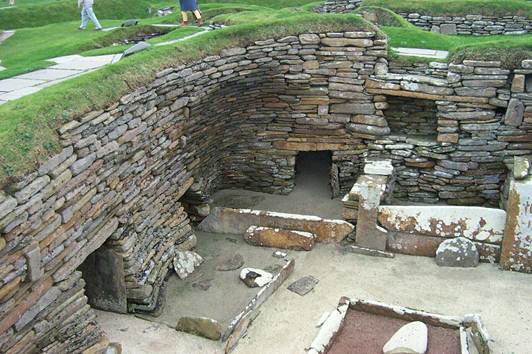Behind their charming facades, Britain’s
villages hide many mysteries.
Rose-framed cottages and the ancient church
tower cluster protectively around the oak-shaded green. Here, in summer, the
crack of willow on leather indicates that cricketers are conducting their
weekly ritual, to utter bemusement of foreign visitors. There’s nothing more
English than the village.

Behind
their charming facades, Britain’s villages hide many mysteries.
But how, and why, did villages first appear
in our landscape, and what made people want to congregate in these small,
tightly knit communities, which in many instances have stood for over 1,000
years?
According to pioneering landscape a land of
villages during the 20 generations that made up the Anglo-Saxon period, between
about AD450 and 1066. Most of our villages date back to that time, and their
names reflect this.

Most
of our villages date back to that time, and their names reflect this.
Wherever you see the suffix ‘ham’, for
example, it was originally a Saxon homestead, and if that’s prefixed by an
‘ing’, such as Franglingham, that means it was the ‘ham’ of the family or group
of people, or the dwellers at a specific place, whose names are usually
preserved in the first element of the placename, ie ‘fram’. A ‘tun’ or ton
meant a farmstead, and the many ‘worths’ indicated an enclosure; a ‘burh’ or
borough, a stronghold, and a ‘cot’ or cote, a cottage. Incidentally,
Piddletrenthide, means village on the river Piddle that is worth 30 hides
(medieval land units).
Scandinavian influence

Celtic
villages
The Danish, or Viking, influence, found
mainly in the north and east of England, is often indicated in village names by
the Old Scandinavian suffix “by”, which also means a farmstead; “thorp”, which
means one outside the main settlement, or “thwaite”, which means a clearing.
Before the Saxon period, prehistoric and
Celtic villages were smaller and much more isolated, such as those still found
in the hill country of the north and west. We’d probably call them hamlets
today. Apart from the obvious fact of their size, the main difference between a
village and a hamlet is usually the presence of a church.
The typical Saxon village came about as a
grouping of families in the center of the parish, or around a key natural
feature, such as a village pond. Villagers later had shares in the great open
fields that had been won from the surrounding wildwood by their ancestors.
Strips of land were allocated to each ‘villein’ (free villager) on the three-field
rotation system where, every year, one field is sown with winter wheat; the
second, a spring-sown crop, such as barley, and the third is left fallow to
recover its nutrients. This ancient system is still employed at places Laxton
in Nottinghamshire and Braunton in North Devon.

The
typical Saxon village came about as a grouping of families in the center of the
parish, or around a key natural feature, such as a village pond.
But that chocolate-box picture of a typical
village we started with is far from reality in many British villages. Below, we
take a look at some of our stranger villages, which often tell entirely
different stories. In some cases, they speak of our ancient past, in others,
they reflect more recent aspects of the social and economic history of our
ever-fascinating countryside.
Stone age village
Skara Brae, Orkney.

the
Neolithic village of Skara Brae on Orkney
Visiting the Neolithic village of Skara
Brae on Orkney is rather like dropping in on Fred Flintstone’s home in Bedrock.
There’s something quite magical about stooping through the low entrance chamber
of a hut and seeing the central hearth, dressers and bed chambers of people who
lived here 5,000 years ago. It’s as if they’ve just left, as a huge storm
crashed in from the Atlantic, burying the village of Skara Brae under fine
sand. Skara Brae, sometimes known as the Pompeii of the north, is the
best-preserved Neolithic village in Europe.
Skara Brae is about six mile north of
Stromness.